一、线程回顾
1.1 初始化线程的 4 种方式
1)、继承 Thread
public static class Thread01 extends Thread {@Overridepublic void run() {System.out.println("当前线程:" + Thread.currentThread().getId());int i = 10 / 2;System.out.println("运行结果:" + i);}}
2)、实现 Runnable 接口
public static class Runable01 implements Runnable {@Overridepublic void run() {System.out.println("当前线程:" + Thread.currentThread().getId());int i = 10 / 2;System.out.println("运行结果:" + i);}}
3)、实现 Callable 接口 + FutureTask (可以拿到返回结果,可以处理异常)
public static class Callable01 implements Callable<Integer> {@Overridepublic Integer call() throws Exception {System.out.println("当前线程:" + Thread.currentThread().getId());int i = 10 / 2;System.out.println("运行结果:" + i);return i;}}
public static void main(String[] args) {FutureTask<Integer> futureTask = new FutureTask<>(new Callable01());new Thread(futureTask).start();System.out.println(futureTask.get());
}4)、线程池
方式 1 和方式 2:主进程无法获取线程的运算结果。不适合当前场景
方式 3:主进程可以获取线程的运算结果,但是不利于控制服务器中的线程资源。可以导致服务器资源耗尽。
方式 4:通过如下两种方式初始化线程池
Executors.newFiexedThreadPool(3);
//或者
new ThreadPoolExecutor(corePoolSize, maximumPoolSize, keepAliveTime, TimeUnit unit, workQueue, threadFactory, handler);
通过线程池性能稳定,也可以获取执行结果,并捕获异常。但是,在业务复杂情况下,一个异步调用可能会依赖于另一个异步调用的执行结果。
1.2 线程池的七大参数
@param **corePoolSize** the number of threads to keep in the pool, even if they are idle, unless {@code allowCoreThreadTimeOut} is set
池中一直保持的线程的数量,即使线程空闲。除非设置了 allowCoreThreadTimeOut@param **maximumPoolSize** the maximum number of threads to allow in the pool
池中允许的最大的线程数@param **keepAliveTime** when the number of threads is greater than the core, this is the maximum time that excess idle threads will wait for new tasks before terminating.
当线程数大于核心线程数的时候,线程在最大多长时间没有接到新任务就会终止释放,
最终线程池维持在 corePoolSize 大小@param **unit** the time unit for the {@code keepAliveTime} argument
时间单位@param **workQueue** the queue to use for holding tasks before they are executed. This queue will hold only the {@code Runnable} tasks submitted by the {@code execute} method.
阻塞队列,用来存储等待执行的任务,如果当前对线程的需求超过了 corePoolSize
大小,就会放在这里等待空闲线程执行。@param **threadFactory** the factory to use when the executor
creates a new thread
创建线程的工厂,比如指定线程名等@param **handler** the handler to use when execution is blocked
because the thread bounds and queue capacities are reached
拒绝策略,如果线程满了,线程池就会使用拒绝策略。
运行流程:
1、线程池创建,准备好 core 数量的核心线程,准备接受任务
2、新的任务进来,用 core 准备好的空闲线程执行。
(1) 、core 满了,就将再进来的任务放入阻塞队列中。空闲的 core 就会自己去阻塞队列获取任务执行
(2) 、阻塞队列满了,就直接开新线程执行,最大只能开到 max 指定的数量
(3) 、max 都执行好了。Max-core 数量空闲的线程会在 keepAliveTime 指定的时间后自动销毁。最终保持到 core 大小
(4) 、如果线程数开到了 max 的数量,还有新任务进来,就会使用 reject 指定的拒绝策略进行处理
3、所有的线程创建都是由指定的 factory 创建的。
面试问题:
一个线程池 core 7; max 20 ,queue:50,100 并发进来怎么分配的:
先有 7 个能直接得到执行,接下来 50 个进入队列排队,在多开 13 个线程继续执行。现在 70 个被安排上了。剩下 30 个默认拒绝策略。
1.3 常见的 4 种线程池
- newCachedThreadPool
core=0,创建一个可缓存线程池,如果线程池长度超过处理需要,可灵活回收空闲线程,若无可回收,则新建线程。 - newFixedThreadPool:
core = max,创建一个定长线程池,可控制线程最大并发数,超出的线程会在队列中等待。 - newScheduledThreadPool
创建一个定长线程池,支持定时及周期性任务执行。 - newSingleThreadExecutor
创建一个单线程化的线程池,它只会用唯一的工作线程来执行任务,保证所有任务按照指定顺序(FIFO, LIFO, 优先级)执行。
1.4 开发中为什么使用线程池
- 降低资源的消耗
通过重复利用已经创建好的线程降低线程的创建和销毁带来的损耗。 - 提高响应速度
因为线程池中的线程数没有超过线程池的最大上限时,有的线程处于等待分配任务的状态,当任务来时无需创建新的线程就能执行 - 提高线程的可管理性
线程池会根据当前系统特点对池内的线程进行优化处理,减少创建和销毁线程带来的系统开销。无限的创建和销毁线程不仅消耗系统资源,还降低系统的稳定性,使用线程池进行统一分配
二、CompletableFuture 异步编排
业务场景:
查询商品详情页的逻辑比较复杂,有些数据还需要远程调用,必然需要花费更多的时间。
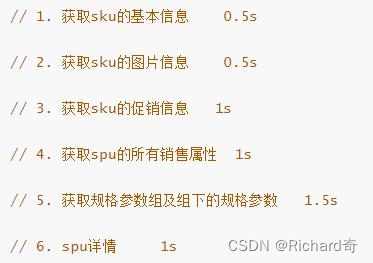
假如商品详情页的每个查询,需要如下标注的时间才能完成,
那么,用户需要 5.5s 后才能看到商品详情页的内容。很显然是不能接受的。
如果有多个线程同时完成这 6 步操作,也许只需要 1.5s 即可完成响应。
2.0 初步认识
在 Java 8 中, 新增加了一个包含 50 个方法左右的类: CompletableFuture,提供了非常强大的Future 的扩展功能,可以帮助我们简化异步编程的复杂性,提供了函数式编程的能力,可以
通过回调的方式处理计算结果,并且提供了转换和组合 CompletableFuture 的方法。CompletableFuture 类实现了 Future 接口,所以你还是可以像以前一样通过get方法阻塞或
者轮询的方式获得结果,但是这种方式不推荐使用。
CompletableFuture 和 FutureTask 同属于 Future 接口的实现类,都可以获取线程的执行结果。
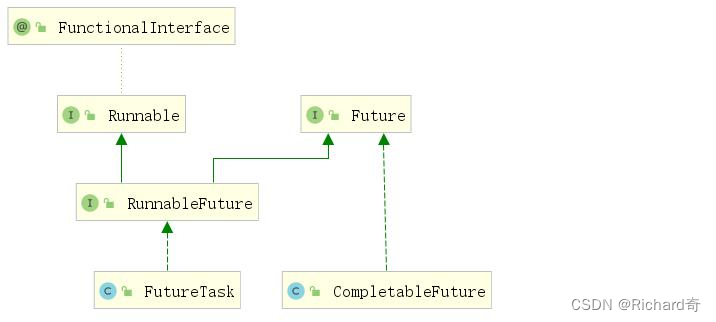
注意(后续不再强调):CompletableFuture中方法不以 Async 结尾,意味着 Action 使用相同的线程执行,而 Async 可能会使用其他线程执行(如果是使用相同的线程池,也可能会被同一个线程选中执行)
2.1 创建异步对象
CompletableFuture 提供了四个静态方法来创建一个异步操作。

区别:
1、runXxxx 都是没有返回结果的,supplyXxx 都是可以获取返回结果的
2、可以传入自定义的线程池(推荐使用),否则就用默认的线程池;
2.2 计算完成时回调方法

whenComplete系列方法只能感知异常,不能修改CompletableFuture的返回值,若要返回异常信息,可以再链式调用exceptionally()方法,并指定一个出现异常以后默认的返回值。
whenComplete()需要传入参数 “消费者” BiConsumer<? super T, ? super Throwable> action,BiConsumer中accept(t,u)方法接收两个参数,第一个参数是future的返回结果,第二个参数是抛出的异常,没有返回值。
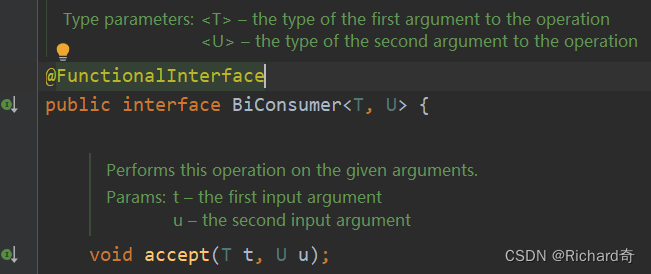
public class ThreadTest {public static ExecutorService executor = Executors.newFixedThreadPool(10);public static void main(String[] args) throws ExecutionException, InterruptedException {System.out.println("main......start.....");CompletableFuture<Integer> future = CompletableFuture.supplyAsync(() -> {System.out.println("当前线程:" + Thread.currentThread().getId());int i = 10 / 0;System.out.println("运行结果:" + i);return i;}, executor).whenComplete((res,exception) -> {//虽然能得到异常信息,但是没法修改返回数据System.out.println("异步任务成功完成了...结果是:" + res + "异常是:" + exception);}).exceptionally(throwable -> {//可以感知异常,同时返回默认值return 10;});System.out.println("main......end....." + future.get());}
}
执行结果:
main......start.....
当前线程:20
异步任务成功完成了...结果是:null异常是:java.util.concurrent.CompletionException: java.lang.ArithmeticException: / by zero
main......end.....10
2.3 handle 方法

和 whenComplete 一样,可对结果做最后的处理(可处理异常),可改变返回值。
handle()方法需要传入参数 BiFunction<? super T, Throwable, ? extends U> fn,BiFunction中的R apply(T t, U u)方法接收两个参数T t 和 U u ,并且有返回值R 。
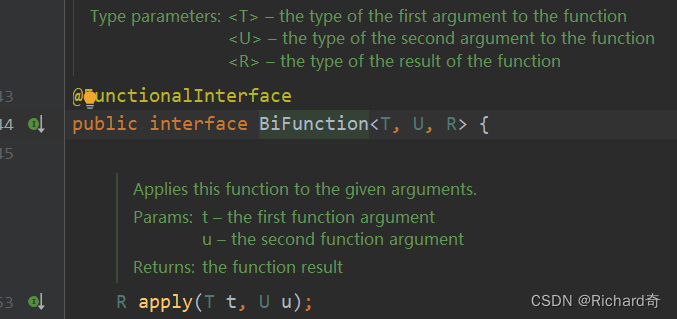
public class ThreadTest {public static ExecutorService executor = Executors.newFixedThreadPool(10);public static void main(String[] args) throws ExecutionException, InterruptedException {System.out.println("main......start.....");CompletableFuture<Integer> future = CompletableFuture.supplyAsync(() -> {System.out.println("当前线程:" + Thread.currentThread().getId());int i = 10 / 2;System.out.println("运行结果:" + i);return i;}, executor).handle((result,thr) -> {if (result != null) {return result * 2;}if (thr != null) {System.out.println("异步任务成功完成了...结果是:" + result + "异常是:" + thr);return 0;}return 0;});System.out.println("main......end....." + future.get());}
}
执行结果:
main......start.....
当前线程:20
运行结果:5
main......end.....10
2.4 线程串行化方法
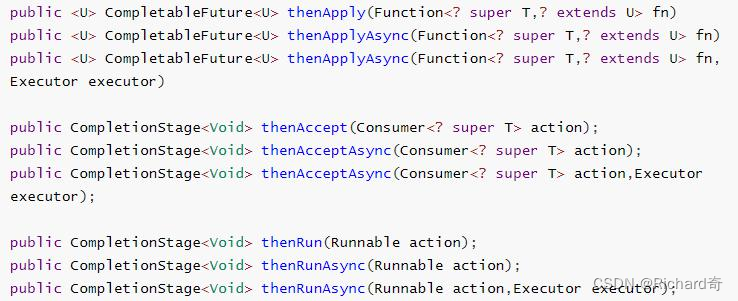
假设B线程需要A线程执行完成之后才能继续执行,则需要线程串行化。
- thenRun系列方法,不需要依赖A返回的结果,没有返回值。
- thenAccept系列方法,需要依赖A返回的结果,没有返回值。
- thenApply系列方法,依赖A返回的结果,有返回值。
具体看三类方法的参数也能看出来:
thenRun系列方法,只传入Runnable行为(不依赖结果),返回值类型是void(无返回值)。
public CompletableFuture<Void> thenRun(Runnable action)
thenAccept系列方法,传入Consumer<? super T> action,只做消费处理(依赖结果),返回值类型是void(无返回值)。
public CompletableFuture<Void> thenAccept(Consumer<? super T> action)
thenApply系列方法,传入Function<? super T,? extends U> fn,函数处理(依赖结果),返回值类型是U(有返回值)。
public <U> CompletableFuture<U> thenApply(Function<? super T,? extends U> fn)
2.5 两任务组合 - 都要完成
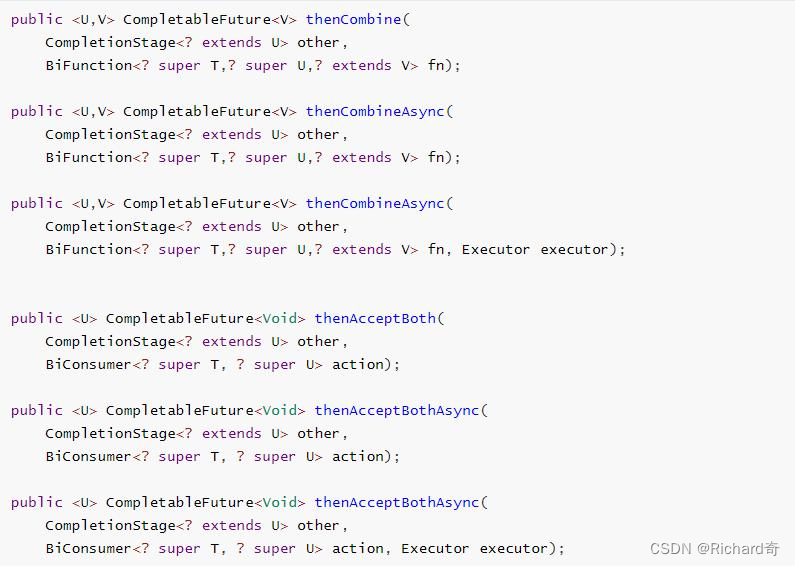

两个任务必须都完成,触发该任务。
- runAfterBoth:组合两个 future,不需要获取 future 的结果,只需两个 future 处理完任务后,处理该任务。
- thenAcceptBoth:组合两个 future,获取两个 future 任务的返回结果,然后处理任务,没有返回值。
- thenCombine:组合两个 future,获取两个 future 的返回结果,并返回当前任务的返回值。
2.6 两任务组合 - 一个完成
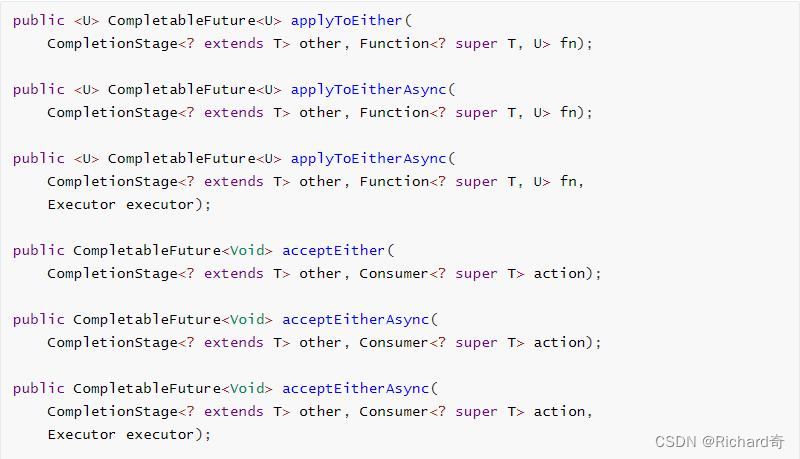

当两个任务中,任意一个 future 任务完成的时候,执行任务。
- runAfterEither:两个任务有一个执行完成,不需要获取 future 的结果,处理任务,也没有返
回值。 - acceptEither:两个任务有一个执行完成,获取它的返回值,处理任务,没有新的返回值。
- applyToEither:两个任务有一个执行完成,获取它的返回值,处理任务并有新的返回值。
2.7 多任务组合

allOf:等待所有任务完成。
anyOf:只要有任何一个任务完成。

)

![机器学习周记(第三十三周:文献阅读[GWO-GART])2024.4.1~2024.4.7](http://pic.xiahunao.cn/机器学习周记(第三十三周:文献阅读[GWO-GART])2024.4.1~2024.4.7)













)

